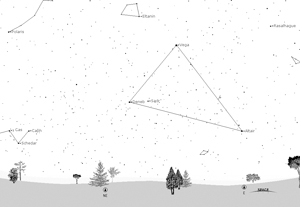STARGAZING
 The Summer Triangle
The Summer Triangle
The season of sunshine and vacations officially begins at 9:24 a.m. EDT on Friday, June 21. This marks the summer solstice. It is the longest day of the year with about 15 hours of daylight.
Contrary to popular belief, the earliest sunrise, longest day, and latest sunset do not happen on the summer solstice. The earliest sunrise of 2002 actually occurs on Friday, June 14 at 5:08 a.m. The latest sunset happens on Friday, June 28 at 8:17 p.m. The cause is quite complicated, but it is related to the Earth’s orbit being elliptical rather than circular.
One way to begin warm weather stargazing is to locate some of the well-known stars of summer. The three bright stars of the Summer Triangle are rising in the east in early evening. Vega is the highest of this asterism, or group of stars. Deneb is toward the northeast. Altair, the third star of the Summer Triangle, is somewhat lower and to the east.
Vega is the brightest star of the triangle. It shines at 29 light years away and is the 5th brightest star you can see from our planet. Through binoculars Vega appears bluish-white due to its high temperature of 18,000 degrees F. The diameter is 2 million miles. If you compare the temperature and size of Vega to that of the sun, Vega would be twice as hot and twice as wide. If Vega were to replace our sun, it would shine 58x brighter.
The second brightest star in the Summer Triangle is Altair. This star belongs to the constellation Aquilla, the Eagle. It is only 16 light years away and the 12th brightest star in the night sky. Altair is about 1 1/2 x the size of the sun and 9x brighter. While it takes earth about 24 hours to rotate once on its axis, Altiar rotates once in just 6 1/2 hours. A day on Altair is 1/4 of an earth day. Altair spins so rapidly that it causes the star to bulge in the middle.
The third star of the asterism is Deneb. Deneb marks the swan’s tail in the constellation Cygnus. This bluish-white supergiant shines at a distance of 1,800 light years from earth. It is set against the background of the Milky Way. As our solar system orbits around the galaxy, it’s moving in the direction of Deneb at a speed of 250km per second.
If you locate the Summer Triangle at the beginning of summer, you will be able to track it as it moves slowly across the sky from east to west. It rises in the east just after dark in early summer and dominates the northeastern sky in mid -July and August. By late September, the triangle will be getting ready to set low in the northwestern sky marking the end of the summer season.
The summer heavens are loaded with spectacular sights for the casual stargazer. The Summer Triangle is just one of the many points of light to enchant your evenings. I wish you sunny summer days and crystal clear nights.
Happy Stargazing!
- Celebrating 20 Years Of Community At The Stand - April 12, 2024
- First Positive Case Of Chronic Wasting Disease In Indiana - April 12, 2024
- Southwest Allen County Schools Embark On Major Tree Plantings - April 12, 2024


